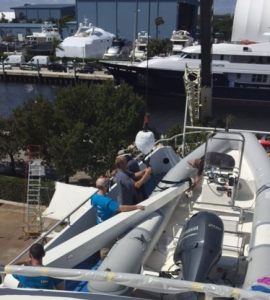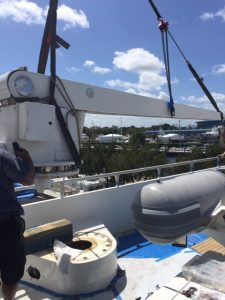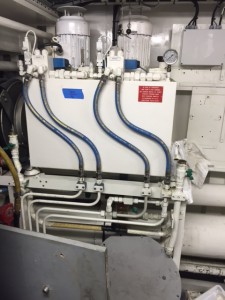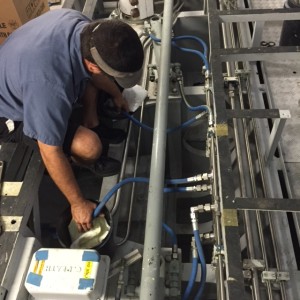To keep your stabilizers in top working order, it is important to follow the manufacturer’s recommended scheduled maintenance to ensure smooth sailing in rough seas. ABT Trac, one of the more popular brands, recommends changing the lower stabilizer fin seals every couple of years but at least every six years depending on use. The components on the stabilizer are constantly working except is absolute calm seas, so the wear and tear can be considerable.

Dropped Fin
When an 80-foot Limon Heesen yacht was hauled at Lauderdale Marine Center, our team at High Seas Hydraulics was tasked with changing out the lower stabilizer fin seals. We first had to drop the fins from the vessel before accessing the lower stabilizer fin seals. It is important when having this service performed on your yacht that you select a yard and a hydraulics company that has the proper tools and training to perform the job.
At High Seas Hydraulics, we believe in investing in our technicians to further hone their skills. That is why we have send some of our hydraulics technicians to ABT Trac for training on their systems. Those technicians are now Factory Trained and Certified to work on all types of ABT Trac systems.

New lower seal
After dropping the fins, we proceeded to change out the old lower stabilizer fin seals with new ones, apply motor oil, check the hoses and cylinders, then reassembling the units before sea trialing the boat to ensure everything was in proper working order.
Stabilizers are an important component in keeping your yacht comfortable and safe when encountering rough seas.






 adjust the straps in order to control the unit as it was lifted into the air. Cranes have a very uneven weight distribution and weigh several hundred pounds so without the proper balance applied by the straps and chain come-along, they could twist or slip potentially hitting the deck or the side of the yacht while being lowered to the ground.
adjust the straps in order to control the unit as it was lifted into the air. Cranes have a very uneven weight distribution and weigh several hundred pounds so without the proper balance applied by the straps and chain come-along, they could twist or slip potentially hitting the deck or the side of the yacht while being lowered to the ground.

